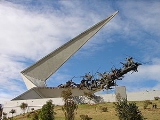
Vargas Swamp Lancers
Encyclopedia
Vargas Swamp Lancers or Monumento a los Lanceros is a large sculptural complex realized by colombian artist Rodrigo Arenas
Betancur in the department of Boyacá
(Colombia
) as a memorial for Vargas Swamp Battle
. It is the largest monument in Colombia.
This monument depicts the attack of the 14 lancer
s commanded by Colonel Juan José Rondón. It is 33 m high and was dedicated in the 150th anniversary of the Colombian Declaration of Independence
(1970).
, the army of Simón Bolívar
, exhausted after passing across the Pisba
paramount, faced the Spanish army commanded by José María Barreiro.
Although the location was better for the Spanish, and Bolívar's army faced bad odds, the attack of the 14 lancers, armed only with lance
s, was decisive in the winning of the battle.
sculpture, depicting the 14 soldiers and their horses, suspended in the air and framed in a concrete
structure.
Rodrigo Arenas
Rodrigo Arenas Betancur was a Colombian sculptor, born on October 23, 1919 in Fredonia, Antioquia. At the time of his death in 1995 he was recognized as one of the most important sculptors in Colombia and Latin America...
Betancur in the department of Boyacá
Boyacá Department
Boyacá is one of the 32 Departments of Colombia, and the remnant of one of the original nine states of the "United States of Colombia".Boyacá is centrally located within Colombia, almost entirely within the mountains of the Eastern Cordillera to the border with Venezuela, although the western end...
(Colombia
Colombia
Colombia, officially the Republic of Colombia , is a unitary constitutional republic comprising thirty-two departments. The country is located in northwestern South America, bordered to the east by Venezuela and Brazil; to the south by Ecuador and Peru; to the north by the Caribbean Sea; to the...
) as a memorial for Vargas Swamp Battle
Vargas Swamp Battle
Vargas Swamp Battle was an armed conflict that occurred near Paipa, on July 25, 1819. The joint Venezuelan and Neogranadan army commanded by Simón Bolívar was trying to prevent the Spanish forces from arriving at Santafe de Bogotá, which was lightly defended, before they did...
. It is the largest monument in Colombia.
This monument depicts the attack of the 14 lancer
Lancer
A lancer was a type of cavalryman who fought with a lance. Lances were used in mounted warfare by the Assyrians as early as and subsequently by Greek, Persian, Gallic, Han-Chinese, nomadic and Roman horsemen...
s commanded by Colonel Juan José Rondón. It is 33 m high and was dedicated in the 150th anniversary of the Colombian Declaration of Independence
Colombian Declaration of Independence
Colombian Declaration of Independence refers to the historic events which happened on July 20,1810, in Santa Fe de Bogota, at the time the Viceroyalty of New Granada seceded and the related events around this date that defined the uprising of the Republic of Colombia.- Background :An important...
(1970).
The Lancers
In July 1819, while marching against SantaféBogotá
Bogotá, Distrito Capital , from 1991 to 2000 called Santa Fé de Bogotá, is the capital, and largest city, of Colombia. It is also designated by the national constitution as the capital of the department of Cundinamarca, even though the city of Bogotá now comprises an independent Capital district...
, the army of Simón Bolívar
Simón Bolívar
Simón José Antonio de la Santísima Trinidad Bolívar y Palacios Ponte y Yeiter, commonly known as Simón Bolívar was a Venezuelan military and political leader...
, exhausted after passing across the Pisba
Pisba, Boyacá
Pisba is a town and municipality in Boyacá Department, Colombia, part of the subregion of La Libertad Province....
paramount, faced the Spanish army commanded by José María Barreiro.
Although the location was better for the Spanish, and Bolívar's army faced bad odds, the attack of the 14 lancers, armed only with lance
Lance
A Lance is a pole weapon or spear designed to be used by a mounted warrior. The lance is longer, stout and heavier than an infantry spear, and unsuited for throwing, or for rapid thrusting. Lances did not have tips designed to intentionally break off or bend, unlike many throwing weapons of the...
s, was decisive in the winning of the battle.
The monument
The monument of Arenas Betancur, is a bronzeBronze
Bronze is a metal alloy consisting primarily of copper, usually with tin as the main additive. It is hard and brittle, and it was particularly significant in antiquity, so much so that the Bronze Age was named after the metal...
sculpture, depicting the 14 soldiers and their horses, suspended in the air and framed in a concrete
Concrete
Concrete is a composite construction material, composed of cement and other cementitious materials such as fly ash and slag cement, aggregate , water and chemical admixtures.The word concrete comes from the Latin word...
structure.

